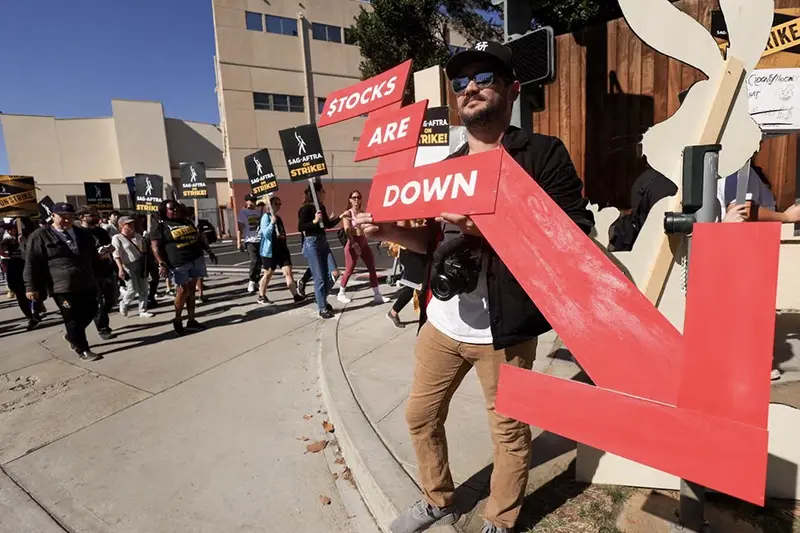February 6, 2024 – 5:05 AM PST

(Reuters) – When stars returned to the red carpet in early January after two bruising strikes to celebrate the success of “Oppenheimer” and “Succession,” one existential threat above all was on everyone’s mind: Hollywood is shrinking.
The era of “peak TV,” is over, said 17 entertainment business executives, agents and bankers who spoke with Reuters. From fewer original series and movies to greater scrutiny of budgets and a further squeeze on movie theater profits, people who call the shots said the television and film industries are adjusting to sober economic realities.
“The great contraction is upon us,” said one veteran television executive, speaking on condition of anonymity. “I think there will be a significant retrenchment in the quantity of content, and the amount spent on content.”
The contraction story will figure prominently as Walt Disney (DIS.N), Warner Bros Discovery (WBD.O) and Fox (FOXA.O) report quarterly results this month. It is also the backdrop for media merger chatter, most recently sale talks between the owner of Paramount Global (PARA.O) and Skydance Media CEO David Ellison, the media mogul whose studio co-produced “Top Gun: Maverick.”
Analyst TD Cowen estimated broadcast and cable television advertising will end 2023 down 7% from the prior year, with total advertising declines of 11.7% at Disney, according to LSEG. Warner Bros Discovery reported a 13% decline in advertising for the first nine months of 2023. Along with print and radio, traditional TV has been “hollowed out” by digital advertising.
The outlook for 2024 is not much better. TD Cowen forecast that broadcast and cable TV ad revenue would fall another 7%. Even though the media companies are expanding their digital ad businesses, the sinking traditional TV business still accounts for 80% of their total advertising revenue, according to TD Cowen.
Streaming services, which were supposed to carry the industry into the future, are also struggling to reach profitability after years of profligate spending. As the industry enters what MoffettNathanson describes as the “third act of the streaming wars,” production spending will fall below 2022 levels, when competition stoked “never sustainable” investment.
Most streaming services are charging more while delivering less new content, feeding skepticism over their long-term strategy, according to TD Cowen.
The overall number of scripted series is expected to shrink dramatically from the pinnacle of 633 shows released in 2022. The combination of the Hollywood strikes and constrained spending dented production last year, with just 481 U.S. series released in 2023, according to data from market research firm Ampere Analysis.
Even market-leading Netflix (NFLX.O) slashed the number of scripted series it released by more than one-third from 2022 to 2023, Ampere said. The profitable streaming service, which reported record subscriber gains in its fourth quarter, declined to comment.
Executives who spoke to Reuters said the industry could shed more scripted series and hit the 300-shows range in coming years.
In 2024, the domestic box office will continue to feel the impact of the actors and writers strikes, with just 90 films offered for wide release this year, down from around 100 in 2023, according to MoffettNathanson. With a film slate heavy in untested stories and characters, U.S. box office sales are expected to be $8 billion in 2024, down 10% from 2023 and down 30% from 2019.
‘NEW WORLD ORDER’
The industry is slowing down, executives said. Development executives are taking longer to greenlight shows, even for projects from established showrunners like Ronald D. Moore, whose credits include “For All Mankind” and “Outlander.”
Production budgets are contracting — including at the streaming service Apple TV+, whose cash-flush corporate parent, Apple, boasts a market capitalization of $3 trillion. Both examples are reported here for the first time.
Shows that fail to grab an audience are being canceled quicker, as with the Disney+ series “American Born Chinese,” an adaptation of a groundbreaking graphic novel featuring two Oscar winners, Michelle Yeoh and Ke Huy Quan.
One senior television agent called it “the new world order,” with shorter seasons and fewer episodes per season.
Fox is looking to slash spending on one prestige drama to $4.5 million per episode from $10 million. At Disney, where CEO Bob Iger is fending off activist shareholders, development executives are under deeper scrutiny.
“They’re all a bit scared about what to do next,” said one prominent talent manager.
“SUPERHERO FATIGUE”
The movie business is having its own existential crisis as once reliable formats have fallen flat at the box office. One longtime studio chief said he has been hearing for years about “superhero fatigue.” That was in full display last year, when a procession of big-budget but poorly received films, including “The Marvels,” “Shazam: Fury of the Gods” and “The Flash,” fell short of expectations.
In response, industry insiders say studios will focus on fewer but more ambitious endeavors, with the potential to deliver “Oppenheimer” and “Barbie”-sized cultural and box-office impact. Both films helped prop up a 2023 box office where well-established franchises fell flat.
“You’ve got to have a spectacle,” said one studio executive associated with one of the biggest blockbusters in recent years. “It’s got to be, ‘You have to see it while it’s in the theater.’ We can’t greenlight something large scale, if you could probably watch this at home and it’s just as good.”
Audiences are gravitating to streaming services to watch all but the biggest, loudest, films, noted TD Cowen. Just 19 action/adventure films accounted for 56% of the total box office for the top 100 films of 2022. The outlook for a sustained recovery, beyond this type of high-adrenaline flick, is questionable, TD Cowen noted.
That will further constrain cinemas, said another longtime media executive and investor, who warned there will be too few films released to justify maintaining 39,000 screens in the U.S., a sentiment echoed by TD Cowen. The theater business, this executive said, is “teetering on disaster.”
Reporting by Dawn Chmielewski in Los Angeles, edited by Kenneth Li and David Gregorio

